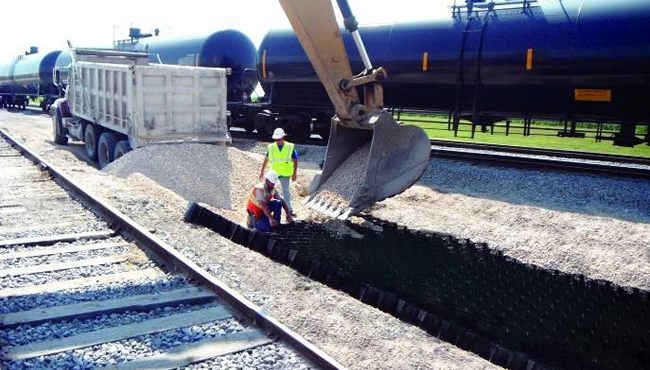A portion of a railway track in Fort Lauderdale, Florida had been a high maintenance area for many years due to the impact loads from rail cars transitioning off of a concrete bridge abutment onto ballasted concrete ties. The ties were located over soft subgrade, which had exhibited a history of pumping. The rail operator, Florida East Coast Railway, sought a ballast stabilization solution to correct the historical and ever-more expensive maintenance cycle at this abutment.
A geocellular confinement solution from Presto Geosystems was selected. It proved to be an exemplary use.
“The area with the geocell system has been subjected to 25 MGT this year with no deflection. The other end of the bridge without the GEOWEB system has settled over 2 inches and has been resurfaced twice.”
The three-dimensional, high-stiffness-promoting geotechnical solution (GEOWEB®) has grown substantially in load support applications with bridge approaches, diamond crossings, and turnouts in railway systems.
RELATED: Geostructural Aspects of Pavements, Railways, and Airfields
RAILWAY BALLAST STABILIZATION IN FLORIDA
FEC operates 351 miles of mainline track along Florida’s east coast. It is the exclusive rail provider to South Florida’s high-volume ports. These rail lines connect with other railway systems to move freight around the United States.
RELATED: Geocells Excel in Track Ballast Research Study
The ballast stabilization evaluation process at the site considered various mechanical load support solutions. Subgrade testing with the known and forecasted track usage helped identify the value and performance that would be provided by a geocellular load support system.

Read about the rigorous track testing conducted by Oregon State University’s Dr. Ben Leshchinsky, P.E. and the University of Kansas’s Dr. Jin Han, P.E. on geocellular systems in railway ballast applications.
The GEOWEB® system from Presto Geosystems was selected based on the site conditions and the load distribution and performance longevity needs. While geosynthetic materials are typically supported by a large volume of standardized data on each product, the design team here had not only strong product data but 30 years of Presto’s rail industry interaction and independent testing conducted at the renowned AAR FAST High Tonnage Loop in Pueblo, Colorado.
In this construction, the geocell performs like a semi-rigid slab as it confines the ballast and reduces the vertical stresses reaching the subgrade.
SITE COMMENTS FROM THE OPERATOR & CREW
“FEC installed the GEOWEB system on the south end of the western track extending from the bridge approach through the heavily travelled grade crossing,” said Charles Stone, Assistant Chief Engineer for Design and Construction at the railway operator.
The installation time was minimal, Houston Spears, P.E., noted. Spears served as the Project Manager for Gonzales & Sons Equipment, Inc. It provided a dramatic time and cost savings versus an asphalt solution.
“Since the location was pumping, we had to excavate and grade the sub-base lower than normal,” said Spears. “For this particular location, we completed the sub-base preparation and installation of the GEOWEB material in approximately three hours. If hot mix asphalt had been used, in proper lifts and thicknesses, it would have been an all-day process and at least twice as expensive. We would have required pavers, and additional compaction equipment.”
“The area with the geocell system has been subjected to 25 MGT this year with no deflection,” Stone added. “The other end of the bridge without the GEOWEB system has settled over 2 inches and has been resurfaced twice.”
The end result has been a more durable subgrade that will increase railway life by preventing long-term settlement and consolidation. The ability to quickly install geocellular panels and limit the track downtime was critical in maintaining operations.
Learn more about Presto Geosystems, GEOWEB, and other engineered systems and engineering services at www.prestogeo.com.











